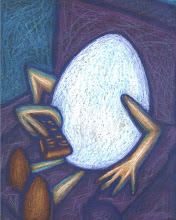The Mummy
This image is available for sale on ebay:
http://www.ebay.com/itm/261631030157?ssPageName=STRK:MESELX:IT&_trksid=p3984.m1555.l2649
Could there be a more famous horror character than the cursed Egyptian mummy returning from the dead?
I think not!
The entire process of Egyptian mummification was to house the "ka," the one part of us that will live on in the afterlife. For the ancient Egyptians, taking care of the ka was extremely important for the afterlife. Their entire life on this planet was a preparation for the afterlife and each person's "ka" needed some sort of a vessel or shell to house it. During mummification, every internal organ was taken out of the body and placed in canopic jars except for the heart which was the seat of the "ka." The heart was placed back inside the wrapped body that we call a mummy.
The concept of a "ka" was much more complex than the Christian soul. In fact, the idea of a soul was only one of eight parts of the "ka." Your personality was another of these parts.
Every thing an Egyptian did in this life would affect the "ka." and a person crossing over to the underworld would be judged by Osiris to see if they had lived a good life or a bad life. Your "ka" inside your heart would be placed on a scale. The feather of Maat, (the Egyptian goddess of truth) would be placed in the opposite scale. If your heart (ka) was lighter than the feather, it meant you were a good Egyptian and would remain in your shell body in the underworld. If your heart was heavier than the feather, Ammit the Egyptian god that was part crocodile would eat your ka and you would wander the underworld as a lost soul. (or what we would call a ghost)
This image is available on ebay:
http://www.ebay.com/itm/261631030157?ssPageName=STRK:MESELX:IT&_trksid=p3984.m1555.l2649























